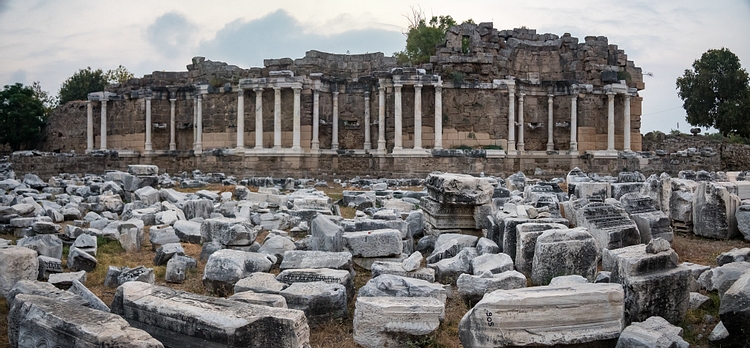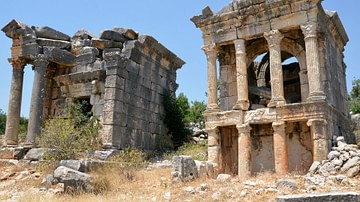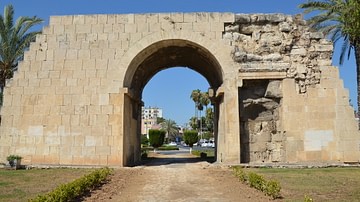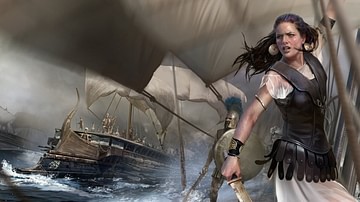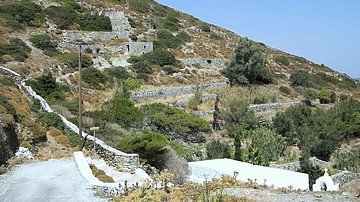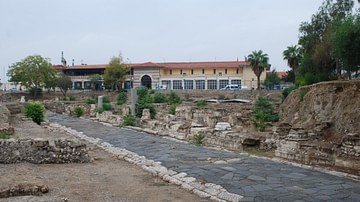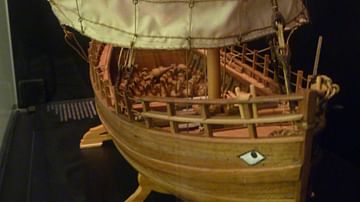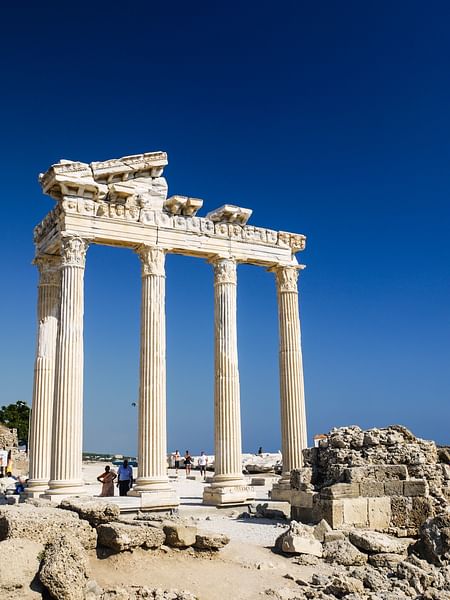
Side (pronounced see-day) was a city on the southern coast of Cilicia (modern-day Turkey) first settled in the 7th century BCE by immigrants from Cyme, an Aeolian municipality to the north near the kingdom of Lydia. Its name means 'pomegranate' in Greek. The first settlers may have been a mixture of Luwians and Hatti and spoke a language (now known as Sidetic) which has not yet been deciphered. Side was Hellenized after the conquest of Cilicia by Alexander the Great (l. 356-323 BCE) and significantly developed by Rome after it became involved in the region c. 103 BCE.
The city was the most infamous slave port in the Mediterranean between the early 2nd century BCE and c. 66 BCE and more or less under the control of the Cilician pirates until they were conquered by Pompey the Great (l. c. 106-48 BCE). Even after the pirates were defeated and relocated, Side continued as a conduit for slaves sold to Greece and Rome and became wealthy almost entirely due to the slave trade.
Raids by mountain bands on the city in the 4th century CE contributed to its decline as well as the rise of Christianity, which resulted in the decline of its pagan shrines, temples, and baths. The city was sacked and burned in the 7th century CE by an Arab fleet in the course of the Muslim conquest of Cilicia and was finally abandoned in the 10th century CE when its citizens relocated to the nearby city of Attalia (modern-day Antalya). Afterwards, Side became a kind of ghost town, and the lack of development preserved Roman structures like the theater, baths, temples, and nymphaeum which are part of the historic district popular with tourists in the present day.
Early History
Cilicia was inhabited by the people known as the Luwians and the Hatti by c. 2500 BCE although human habitation in the region goes back to the Neolithic Period. The region was conquered by a number of different empires beginning with the Akkadians who held it between c. 2334-2083 BCE. The next conquest came when the Hittite Empire invaded and held it between c. 1700-1200 BCE.
Side at this time was most likely an uninhabited promontory in the untamed part of the region known as Rough Cilicia. From its earliest mention in history, a distinction is made between “Smooth Cilicia”, referring to the fertile lowland plains, and “Rough Cilicia”, designating the mountains and rocky coast. The site of future Side may have been visited by the Sea Peoples, a coalition of different nationalities who ravaged the Mediterranean world between c. 1276-1178 BCE as they moved along the coast.
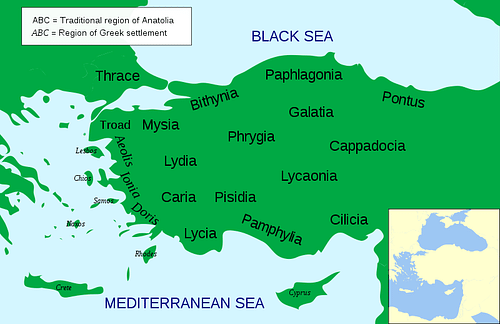
The Sea Peoples contributed to the instability of the Hittite Empire and, after its fall, control of the region reverted back to the Hatti until the Assyrian Empire took Cilicia c. 700 BCE. It would have been sometime shortly before this that part of the population of Cyme migrated south to found what would become the city of Side.
When they arrived, they found people already living in the region who are now known as Pamphylians but what they may have called themselves is unknown. The region of Pamphylia was made up of different nationalities, some indigenous (possibly Luwians), some Hittite, some Greek, and no doubt others as well. They spoke what may have initially been a hybrid language of Greek and Luwian or something else but, by the 7th century BCE, was its own tongue which the settlers from Cyme could not understand. The Roman historian Arrian (l. c. 86 - c. 160 CE) gives this account in his Anabasis of Alexander:
These people [of Side] give the following account of themselves, saying that their ancestors starting from Cyme, arrived in that country, and disembarked to found a settlement. They immediately forgot the Grecian language, and forthwith began to utter a foreign speech, not, indeed, that of the neighboring barbarians, but a speech peculiar to themselves, which had never before existed. From that time the Sidetans used to speak a foreign language unlike that of the neighboring nations. (Chapter XXVI)
The language is very poorly attested in the present day as it has been found on a few coins from the 5th-3rd centuries BCE and two inscriptions in Greek and Sidetic from the 3rd-2nd centuries BCE. Even these bilingual inscriptions have done nothing to help define or translate Sidetic script. The name Side is Sidetic but no one knows what it means; it is Greek for 'pomegranate', but this sheds no light on what its Sidetic meaning was.
Alexander the Great & Hellenization
Wherever Sidetic came from, it was the language of the city – and apparently only that city – in 333 BCE when Alexander the Great led his armies through the Cilician Gates of the Armenian Plateau and took the city of Tarsus before marching the 323 miles (520 km) to Side which opened its gates to him. Alexander left a garrison and administrator behind and moved on with his campaign against Persia.
The Macedonian-Greek garrison most likely had an impact on the people of Side but Hellenization became more widespread after Alexander's death in 323 BCE when Side came under the control of his general Ptolemy I Soter (r. 305-282 BCE) who founded the Ptolemaic Dynasty (305-30 BCE). Greek became the standard language of Side during this time as evidenced by coins and one of the bilingual inscriptions mentioned above.
Cilicia as a whole was divided between Ptolemy I and Seleucus I Nicator (r. 305-281 BCE), founder of the Seleucid Empire (312-63 BCE). The Ptolemies held Side until the 2nd century BCE when it was taken by the Seleucids but their power was on the wane from 190 BCE forward. By c. 152 BCE, the Seleucid Empire had devolved into civil war as its nobility fought over the kingship. In 140 BCE, the Seleucid king Diodotus Tryphon (r. 140-138 BCE) usurped the throne and used Coracesium as a base of operations for launching attacks, which was only 39 miles (64 km) up the coast from Side. According to Strabo, Diodotus Tryphon encouraged piracy in the area through his own example of lawlessness (Geography, XIV.5.2). Side at this time became a haven for pirates and, in time, they would come to control the city.
Cilician Pirates & Rome
Side became the center for the Mediterranean slave trade which had already been established long before Diodotus Tryphon allegedly encouraged it. The Seleucid and Ptolemaic empires both used slaves and had turned a blind eye to the pirates' activities in Cilicia precisely because they supplied the empires with slaves. The pirates would either raid coastal towns and ports for slaves or use deceit to enslave people. A notorious trick, used by pirates down through the time of the writer Pausanias (l. 110-180 CE), was to dock at a port pretending to be traders. The pirates would advertise their goods, drawing the citizens closer and closer to their ships, and then swiftly drive them onboard and sail away.
Rome had taken Cilicia from the Seleucids in 190 BCE but, as per the Treaty of Apamea (188 BCE), allowed Seleucid rulers to retain their positions as client kings. The Romans were also aware of the problem of piracy but ignored it for the same reasons the Seleucids and Ptolemies had. It is estimated that at least 25% of the population of Rome at that time was enslaved, and the Romans were not about to interfere with that trade as long as they were benefitting from it and the slaves were coming from somewhere else.
In 140 BCE, Rome sent Scipio Aemilianus to look into the piracy problem in Cilicia and suggest possible solutions. Scipio returned with a report that immediate action was required because the local rulers were helpless in addressing the situation since they were too busy fighting with each other. Rome blamed the problem on the Seleucid kings and was too busy with other affairs to become involved. By 103 BCE, however, the pirates were disrupting Roman trade and so the general Marcus Antoninus (l. 143-87 BCE, grandfather of Mark Antony) marched on the region and subdued Smooth Cilicia in order to stamp out piracy. He firmly established a Roman presence in the region but did nothing to curtail the pirates who mostly operated out of Rough Cilicia anyway.
Between 78-74 BCE, the consul Publius Servilius Vatia (served 79 BCE) struck at the Isaurians of Rough Cilicia for the same reason and achieved the same results: he conquered the Isaurians but that did nothing to slow or stop piracy. Toward the end of his campaigns, in fact, a young Julius Caesar would be kidnapped and held for ransom by Cilician pirates in 75 BCE. Shortly afterwards, Pompey the Great was in the region fighting Mithridates VI of Pontus (r. 120-63 BCE) and found that Mithridates VI was employing the pirates to strike at Rome and weaken the war effort.
Unlike the earlier Roman attempts, Pompey took the fight to the pirates at sea. He divided the Mediterranean into 13 districts and assigned a Roman fleet and commander to each. As the pirates in one section were dealt with, the Roman fleet would join with another in the next and so on, narrowing down the pirates' playing field so they could be destroyed in a single engagement. Pompey finally defeated them in 67 BCE at the Battle of Coracesium, relocating survivors to the lowlands. Although this solved the problem for the moment and certainly damaged the war efforts of Mithridates VI, it did not end piracy in the Mediterranean and Side would continue as both a slave market and pirate haven for years to come.
Roman Side
Pompey divided Cilicia into six districts with Smooth Cilicia now becoming Cilicia Campestris and Rough Cilicia called Cilicia Aspera. Side was included in the district of Cilicia Aspera. After the Battle of Actium in 31 BCE, Rome became an empire under Augustus Caesar (r. 27 BCE - 14 CE) and Augustus made further alterations to Cilicia as the new province of Syria-Cilicia Phoenice in 27 BCE. In 25 BCE, he joined Side to the new province of Galatia after its king, Amyntas (r. 36-25 BCE) was assassinated and the territory was claimed by Rome.
As part of Roman Galatia, Side prospered due primarily to the slave trade. The Roman Empire, with its many provinces, needed even more slaves than the Roman Republic had. Official slave ships now largely replaced pirate ships (though piracy was still in practice) and the port of Side became the administrative center for the slave trade in the Mediterranean.
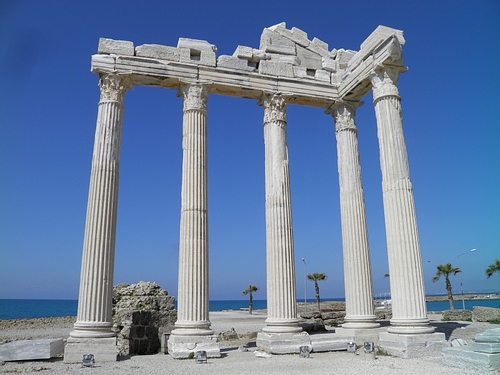
All of the Roman ruins one sees today in modern Side come from this period of c. 1st century BCE to 3rd century CE. The famous Temple of Apollo, the best-known image of Side in the present day, comes from the 2nd century CE while the lesser-known Temple of Athena nearby is somewhat earlier. The theater, which could seat over 15,000 people, the Roman baths, the Nymphaeum, colonnaded streets, the agora, library, and monumental gate, among other structures, were all paid for through the Roman slave trade which made the city, and its merchants, fabulously wealthy.
These merchants who owned the ships and paid the crews did not care how they brought slaves to market as long as the supply kept coming. The official slave ships which were supposed to only take people from “elsewhere” as slaves would often resort to the same tactics as the Cilician pirates had in docking at ports and pretending to be traders. Piracy continued to flourish in the Mediterranean, in fact, precisely because of the slave trade, only this time, since Rome was benefitting famously from it, nothing was done to stop it.
Decline
Side's streets, public buildings, and temples were among the most impressive in the region and the citizens must have felt fairly confident that the winning streak they were on would continue indefinitely. Unfortunately for them, their wealth attracted the attention of the Isaurians of the mountains and other tribes of the rougher parts of Cilicia Aspera who began initiating raids on the city in the 4th century CE. Since the raiders knew the country well, they could strike and vanish away again with whatever loot – or citizens to be sold as slaves – they had taken.
At the same time, the new religion of Christianity had been legitimized by Constantine the Great and the Christians objected to pagan structures like the Temple of Apollo and the Temple of Athena which were then left to decay. Since personal hygiene was associated with pagan Rome, Christians were against bathing and so the Roman baths also fell into disrepair as well as the nymphaeum and even the library since Christians were not interested in pre-Christian works. The city continued to dwindle and decay through the Byzantine era (c. 476-700 CE) although it was valued by Christians as a religious center for part of that time.
In the 7th century CE, the Arabs arrived as part of the Muslim conquest of Cilicia, sacking and burning Side and, most likely, taking numerous citizens as slaves. The Byzantines retook Cilicia in 965 CE, but by then it was too late for Side to revive. The raids by the mountain tribes continued and those citizens not taken or killed lived on the mostly deserted city until they left for Attalia in the late 10th century CE. By the 12th century CE, Side was abandoned and, if inhabited at all, it was only by squatters or occasional travelers.
Conclusion
The Ottoman Empire took Cilicia after the fall of the Byzantine Empire in 1453 CE but did nothing with Side. The city and surrounding area remained abandoned until the late 19th century CE when some Turkish refugees from Crete established the village of Selimiye nearby c. 1895 CE. Throughout the early part of the 20th century CE, Side began to revive and received its new life through the tourism trade as people came to see the remarkably preserved Roman ruins.
In the present day, Side is a resort town on the Mediterranean and the merchants run their businesses in the modern marketplace as the ancient Sidetans would have, with shops as open stalls one cannot easily pass by, the salesman out front welcoming potential customers. Tourists enjoy the East Beach and the many fine restaurants, picnics at nearby Manavgat Falls or spelunking at Dudencik Caves, but visitors today still come mainly for the ruins.
Aside from the grand structures and monumental gate in the historic district of the city, one can visit the ruins of the ancient town of Lyrba in the forest near the Manavgat Waterfall or, if one favors a bit more exertion, hike to the ruins of Selge, a town allegedly founded by refugees from the Trojan War made famous by Homer in his Iliad. The ruins in town are the greatest draw, however. The ancient bathhouse is now the Archeological Museum of Side, exhibiting many fascinating artifacts from the ancient city in a unique setting, and the great theater is a perennial favorite. Side thrives today as well as when it was in its prime under Rome primarily due to the ruins which were preserved almost entirely through neglect.

